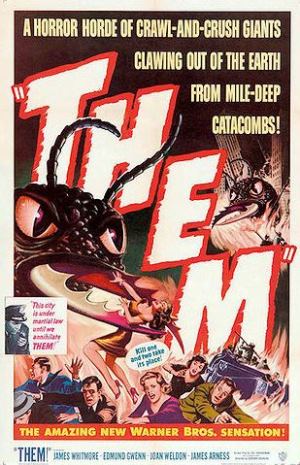
The development of nuclear weapons gave rise to fears across the globe, some more fantastical than others. People imagined all kinds of gruesome ends, including mutant, irradiated organisms. Perhaps the most famous representation of the effects of atomic meddling is Godzilla, which aired in Japan in 1954, nine years after the U.S. dropped atomic bombs on Hiroshima and Nagasaki. That same year, Warner Bros. released a science fiction movie called Them, which features mutant ants irradiated by nuclear tests conducted in New Mexico. The giant ants search for a spot to establish a new nest, causing mayhem and ultimately threatening the human race. While we won’t be battling giant insects in the sewers anytime soon (hopefully), mutant ants just went from science fiction to science fact.
While scientists have been tinkering with the genes of insects such as fruit flies for a long time, ants have proven to be a bigger challenge. In order to perform germline editing—genetic changes passed through generations—scientists have to modify the queen ant who lays the eggs. But there are some types of ants, such as clonal raiders, that reproduce asexually and without fertilization, producing clones of the mothers. Despite the trickiness, researchers at two different institutions recently succeeded in mutating ants.
A study in Cell details how researchers genetically modified clonal raider ants using CRISPR, a gene-editing technique that allows for the cutting and/or pasting of gene sequences. In this study, scientists deactivated the orco gene, which facilitates the proper functioning of ants’ odorant receptors. When ants’ odorant receptors are disrupted, all of their olfactory genes suffer. Those receptors are crucial to ants’ social behavior—pheromones dictate how ants live and work together in a colony. In this study, the modified ants lacked nearly all of the 500 antenna lobe glomeruli, interwoven nerve fibers, synapses, and glial cells, which had a marked impact on their behavior.
The modified clonal raider ants, which are usually repulsed by the smell of Sharpies, sought out the smelly markers (though perhaps they just wanted to get a little loopy after being mutated). They also acted estranged from their friends and family, wandering by themselves and paying little attention to their fellow ants’ pheromones. Once, a female ant swiped an egg and began grooming it. Suddenly, she released panicked pheromones that freaked out the rest of the ants, yet there was no source of danger.
A second study in Cell, which used Indian jumping ants as subjects, also focused on modifying the orco gene. All of these ants have the potential of becoming fertile and becoming “pseudo-queens.” After scientists used CRISPR to deactivate the orco gene, the ants lost roughly 90% of their ability to detect odor. They didn’t hang out with the others in the colony and didn’t search for food. While the ants could still become fertile pseudo-queens, they didn’t lay many eggs and didn’t exhibit the usual maternal instincts for tending them. These ants also didn’t engage in the usual ritual duels to determine which of them might replace a dead queen.
The researchers intend to continue experimenting with genetically modifying ants, particularly to explore the implications of gene editing on their lifespans. The Indian jumping worker ants have an average lifespan of seven months, but the pseudo-queens’ lifespan is four years, a massive difference for ants with the same genes. And when pseudo-queens detect the pheromones of a full queen ant, they revert to worker status and die shortly thereafter. Whatever shifting genetics are at work here have piqued the interest of scientists, who hope to crack and perhaps harness their secrets.
These mutant ants aren’t 50 feet tall—yet—but the success of the experiments guarantees that this isn’t the last we’ve seen of modified insects. Perhaps the man-eating praying mantis is next.
